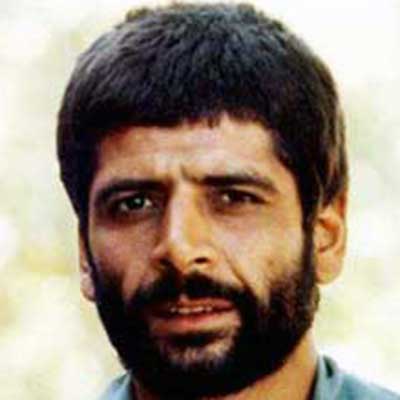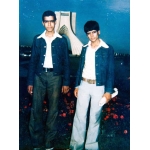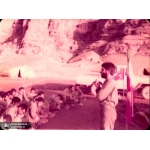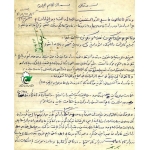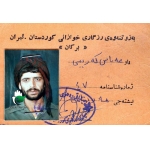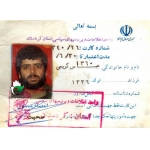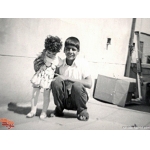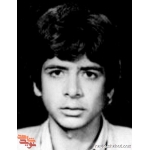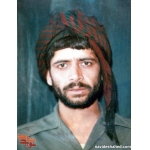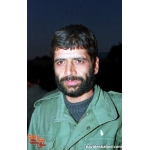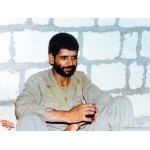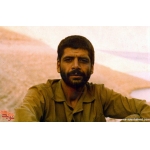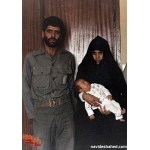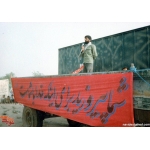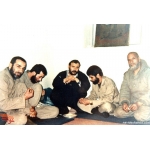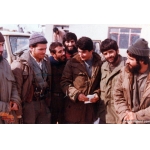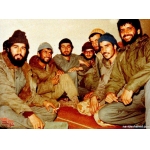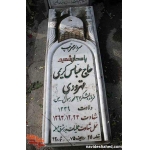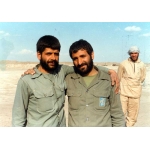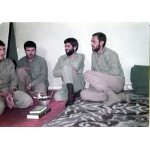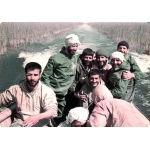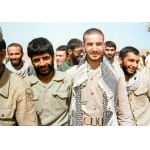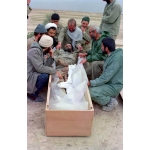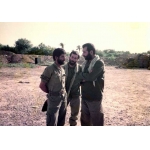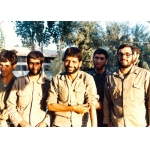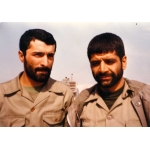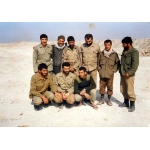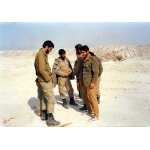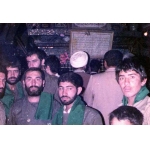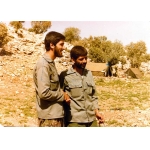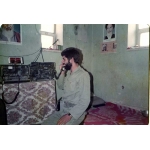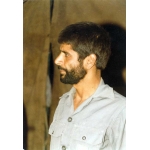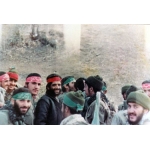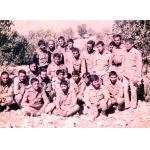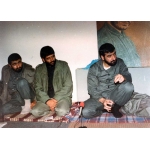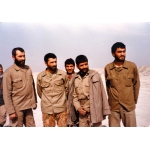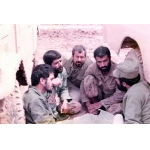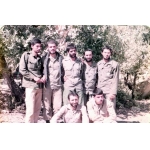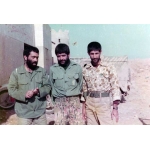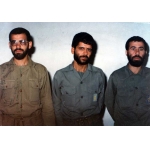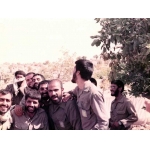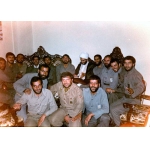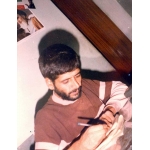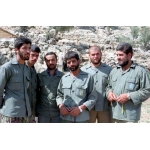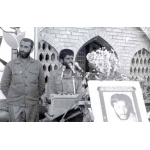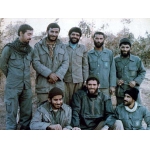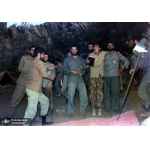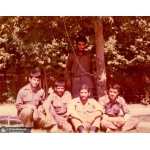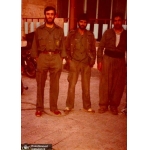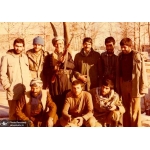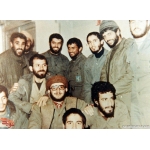Karimi، Abbas
Written by: Leila Heidari Bateni
322 بازدید
Abbas Karimi Qahroodi (1957–1985) was the fourth commander of the 27th Muhammad Rasulullah (pbuh) Division of the Islamic Revolutionary Guard Corps (IRGC) who played a key role in leading various operations during the Iran-Iraq War. He was martyred during operation Badr.
Born in 1957 in the village of Qahrood, near Kashan, Abbas Karimi completed his primary education in his hometown. He then moved to Tehran for further studies before returning to Kashan, where he earned a high school diploma in textiles. Karimi actively supported the movement of Imam Khomeini (ra), distributing leaflets containing his messages and speeches. While serving in the military at the Abbasabad Garrison in Tehran, he joined the Second Bureau of Intelligence Protection of the Islamic Republic of Iran Army. However, his revolutionary activities—distributing Imam Khomeini’s messages among soldiers—led to his arrest and imprisonment. Following Imam Khomeini’s call for soldiers to desert the barracks and join the Revolution, Karimi fled after 14 months of military service and participated in protests held in Kashan.
On February 1, 1979, Karimi joined the Committee for welcoming Imam Khomeini (ra) upon his return to Iran. Following the victory of the Islamic Revolution, he joined the IRGC in Kashan after its establishment (June 5, 1979). Then, he was dispatched to Qom to provide security for Imam Khomeini’s residence. In the winter of 1980, he was sent by the IRGC to Iranshahr in Sistan and Baluchestan Province, where he conducted a three-month operation to combat anti-revolutionary elements, including leftist factions and bandits. His mission was successfully completed by the killing of one of the insurgent leaders.[1]
In Iranshahr, Karimi would dress like a local to earn the public trust, participating in Friday prayers and sports events to communicate with the people.
Given his experience in Iranshahr, he was sent with some of the IRGC forces to Sanandaj in order to deal with the ongoing unrest in Kurdistan triggered by anti-revolutionary groups such as the Democratic Party of Iranian Kurdistan, Rizgari, and Komalah.[2] Karimi went to Sanandaj with the Kashan Guard in 1980 due to his experience of fighting the counter-revolution in Iranshahr. [3]
He soon joined the IRGC in Piranshahr and began collaborating with its operations and intelligence unit, eventually becoming its commander.[4]
His mission was to break the siege of Sanandaj. He not only succeeded in conducting reconnaissance over 80 days but also persuaded Mahmoud Ashtiani, the strategist of the Democratic Party, to surrender along with his forces.[5]
Later on, Ahmad Motevasselian, the commander of the IRGC in Marivan, appointed Abbas Karimi the head of the Marivan IRGC’s intelligence unit. During the early months of the Iran-Iraq War in September 1980, Karimi while fighting against anti-revolutionaries would gather information about the Iraqi forces and military equipment. Given his personal relationship with the locals, he managed to establish an intelligence network and use diplomacy to persuade several armed groups to surrender to the IRGC.[6]
Karimi’s services in the intelligence units of the IRGC in Marivan included participation in operations, clearing contested areas, conducting reconnaissance missions, establishing the cross-border (watching Iraqi forces’ activities across the borders) and domestic (dealing with anti-revolutionary elements controlling the villages) units, and mapping the locations of the enemy forces. Moreover, he engaged in negotiations with anti-revolutionary leaders to encourage them to surrender or make strategic concessions, interrogated the captured insurgent leaders and maintained connections with informants and IRGC contacts. He played a pivotal role in several key operations, including the liberation of the Dezli Heights (December 25, 1980) which resulted in the death of the Iranian Kurdish Democratic Party commander, the Teteh Heights (March 24, 1981), the seizure of the Bani Nobak Garrison in Iraq (May 25, 1981), Quch Sultan (May 26, 1981), and the liberation of the Oramanat (October 7, 1981), as well as the Kamyaran-Sarvabad Road (July 4, 1982).[7] Furthermore, Karimi’s efforts not only facilitated coordination between IRGC forces and Kurdish Peshmerga fighters but also enabled the IRGC to recruit informants from within the Kurdish ranks.[8]
Following the liberation of the Dezli Heights, Ayatollah Seyyed Ali Khamenei—the then representative of Imam Khomeini (ra) in the Supreme Defense Council—visited Marivan on April 27, 1981. As the head of the IRGC intelligence unit, Karimi was responsible for organizing and coordinating this visit.[9] Also, his reconnaissance and intelligence-gathering activities contributed greatly to the success of operation Muhammad Rasulullah (pbuh) on January 2, 1982.[10]
During the formation of the 27th Muhammad Rasulullah (pbuh) Division, Abbas Karimi, as the head of the intelligence-operation unit,[11] established the military-intelligence unit.[12] From then on, he participated in most operations carried out in southern Iran, assuming the responsibility of conducting reconnaissance missions to identify key operational axes.
Before the operation Fath al-Mobin (March 22, 1982),[13] Karimi, along with a small team, located the Iraqi artillery headquarters 20 kilometers beyond the defensive lines. This information enabled the Muhammad Rasulullah (pbuh) Division to seize around 100 artillery guns and mortars.[14] It was during this operation that he was injured and spent 70 days recovering at Najmieh Hospital in Tehran. He was responsible for both operational planning and reconnaissance in operations Ramadan[15] (July 13, 1982) and Moslim ibn Aqil (October 1, 1982).[16]
In October 1982, Abbas Karimi married Zahra Monsef, and they had a son named Davood.[17] The following year, he was appointed head of intelligence unit of the IRGC 11th Qadr.[18] Soon after, he became the commander of the 2nd Salman Brigade of the 27th Muhammad Rasulullah (pbuh) Division leading his troops in operations Valfajr 1 (April 10, 1983- Jabal Fouqi, Iraq)[19] and Valfajr 4 (October 19, 1983- Marivan).[20]
During operation Kheibar (February 22, 1984), as the head of the intelligence unit of the Muhammad Rasulullah (pbuh) Division, Karimi undertook key reconnaissance missions in Hawizeh Marshes while dressing like the locals.[21] After the martyrdom of Muhammad Ebrahim Hemmat, the division’s commander, on March 7, 1984, Karimi was first appointed as the acting commander and then officially took command of the division.[22]
During his year-long command, he managed to finish the construction of a Husayniyya at Dukouheh Garrison which had been built in memory of Hemmat. Also, a naval unit was added to the division and the forces received professional amphibious training.[23] He closely coordinated with the Najaf Operational Headquarters and between the operations Kheibar and Badr organized regular meetings to discuss future strategies and organizational matters, relaying these plans to the Muhammad Rasulullah (pbuh) Division’s command.[24]
On the 14th of March 1985, during the operation Badr in the Hawizeh Marshes, Abbas Karimi was hit by shrapnel from a mortar shell and attained martyrdom. His funeral was held at the Imam Khomeini (ra) Mosque in Tehran, and according to his will, he was laid to rest in section 24 of Behesht Zahra Cemetery next to the grave of his comrades.[25]
[1] Samadian, Maryam, Zire Sayeh Abbas (Under the Shadow of Abbas), Kashan: Morsal, 2004, p. 23; Davoudabadi, Hamid, Dejleh Dar Entezareh Abbas (Tigris Waiting for Abbas), Tehran: Congress Commemorating the Martyred Generals of the Revolutionary Guard and the 36,000 Martyrs of Tehran Province, 1999, pp. 13-25.
[2] Amirnazmi Afshar, Manouchehr, Hajilo, Esfandiar, Contemporary History of Azerbaijan, Vol. 1: Nafye Padeshahi Mashqe Jomhori (The rejection of monarchy, the practice of the republic), Tehran: Soureh Sabz, 2016, p. 13.
[3] Davoodabadi, Hamid, Tigris Waiting for Abbas, p. 24.
[4] Samadi, Mohammad Ali, Yadgar Sardaran, Tehran: Hozeh Honari, 1997, p. 84.
[5] Samadian, Maryam, Under the Shadow of Abbas, pp. 26, 27, and 31; Samadi, Mohammad Ali, Yadgar Sardaran, p. 84.
[6] Kakavandi Jaghasfid, Murad, Osveh Shoja'at Va Esteghamat (An Example of Courage and Endurance), Tehran: Baqir-ul-Ulum Center of the Islamic Revolutionary Guard Corps, 2012, pp. 17-19.
[7] Sadeghi, Reza, Guide Atlas 9: Kurdistan in the Counter-Insurgency War and Sacred Defense, Tehran: Sacred Defense Documentation and Research Center, 2011, pp. 84, 92, 128, 130, and 134.
[8] Shahed Yaran, No. 119, September 2015, pp. 3, 25, 41-43, 93.
[9] Ibid,. p. 45.
[10] Dori, Hassan, Guide Atlas 7: Kermanshah at War, Tehran: Islamic Revolutionary Guard Corps War Studies and Research Center, 2005, p. 68.
[11] Shahed Yaran, p. 11
[12] Ibid,. p. 7.
[13] Foroudi, Ghasem, Atlas of the Western and Southwestern Operational Areas, Tehran: Foundation for the Preservation of Works and Publication of Sacred Defense Values, 2016, p. 48.
[14] Kakavandi Joghasfid, Murad, An Example of Courage and Endurance, p. 19; Shahed Yaran, p. 68.
[15] Rashid, Mohsen, Atlas of the Iran-Iraq War, Tehran: Sacred Defense Documentation and Research Center of the Islamic Revolutionary Guard Corps, Vol. 3, 2013, p. 68; Dori, Hassan, Guide Atlas 7, p. 124.
[16] Shahed Yaran. P. 14.
[17] Kakavandi Joghasfid, Murad, An Example of Courage and Endurance, p. 19. Samadi, Muhammad Ali, Yadgar Sardaran, p. 84.
[18] Shahed Yaran, p. 45.
[19] Forudi, Qasem, Atlas of the Western and Southwestern Operational Areas, p. 94.
[20] Shahed Yaran, P. 9.
[21] Ibid,. pp. 21-49.
[22] Samadi, Mohammad Ali, Yadgar Sardaran, p. 85; Shahed Yarana, p. 52; Behzad, Hossein, Babaei, Gol Ali, Hampay Saeeqeh, Tehran: Hozeh Honari and The 27th Division of Muhammad Rasulullah(PBUH), 2000, p. 805.
[23] Shahed Yaran, P. 52.
[24] Ibid,. p. 59.
[25] Shahed Yaran, p. 53; Samadian, Maryam, Under the Shadow of Abbas, p. 14.


